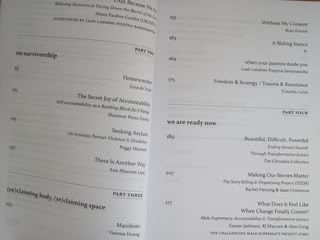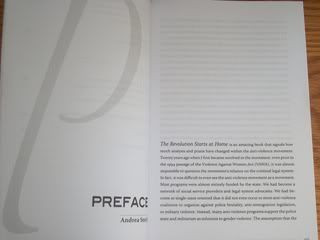An Idiosyncratic Review of The Revolution Starts at Home: Confronting Intimate Violence in Activist Communities Part One
So I have come to grips with the fact that I am not going to read this book all the way through in one sitting, as is my wont. In fact, starting from the front and reading it story by poem by article by interview to the end is not going to work, either. So I decided to stop fighting my brain’s agenda and read and review it, one article at a time; any article that my brain finds interesting this day, this week, this month. Hopefully this will work out so that writers and readers block will be avoided, and I will be able to comment at will on all the small things that strike me as I read the book, as well as the big things.
Let me first comment that this book is beautiful. When I impatiently ripped open the envelope in which it arrived, I was struck with awe and appreciation for the gorgeous frontal illustration.

Description: Photo shows the cover of a book. Two people of color are drawn, holding hands and looking at each other on a balcony. The person on the right has short curly hair and brown skin and is wearing a green t-shirt and jeans. The person on the left has long curly hair caught up in a hair tie at the back of the head and also has brown skin. The person is wearing a light purple t-shirt and yellow belt and brown pants. Both people are wearing bracelets. In the distance are electricity poles and houses. The background colour is a warm orangey red. The text says: “The Revolution Starts At Home: Confronting Intimate Partner Violence within Activist Communities. Edited by Ching-In Chen, Jai Dulani and Leah Lakshmi Piepzna- Smarasinha. Preface by Andrea Smith.”
Curly-haired people of color in simple tshirts and pants, hand in hand, in front of houses that weren’t ridiculous mansions! I admired the handwriting-emulating font that proclaimed the title, and I soaked in the colors and the details of the artwork. And then I opened the book and promptly swooned at the title page design.

Description: Photo shows two pages of a book. On the left page is a gray coloured-heart. The heart is designed to look like its been drawn with a paintbrush, the heart is somewhat faint in places. The right hand side of the book showcases the title page. In somewhat loopy, thin cursive the words “the revolution starts at home” are written in lower case letters. The words “Confronting Intimate Violence Within Activist Communities” are written in all capital letters in smaller, somewhat wide script below that. Below that and to the right, the words “Edited by” are in tiny capital letters, and the words Ching-In Chen, Jail Dulani, and Leah Lakshim Piepzna-Smarasinha” follow, one name after another, in the usual manner of name-writing. (First letter of name capitalised, the rest of letters in lower case.) There is a large space, the further down the page, the words “Preface by Andrea Smith”, follow the same format. Finally the name of the publisher, “South End Press” starts on the left hand side of the page, using the same lower case loopy cursive that was used for the book title. Below this in small capitals are the physical locations of South End Press and its motto: “Brooklyn, NY:: Boston MA:: Read. Write. Revolt.”
I couldn’t help it, I’d just read the paperback versions of Miss Rythmn: The Autobiography on Ruth Brown, which has a positively HIDEOUS cover design. I cannot EVEN with that arrangement of colours, much less the choice of typeset! The disservice to the story is a bloody crime, frankly, and the contrast between that disaster and the graceful, thoughtful and all around aesthetically pleasing setup of The Revolution Starts at Home was very. VERY sharp. I mean, I had design-gasms over the content page arrangement:
…nevermind the moment of supreme happiness I experienced when I laid eyes on the chapter page announcing the preface and its author!
blockquote>Description: Photo shows two pages of a book. On the left hand side is the chapter’s name: Preface (in capital letters and black font). The Author’s name is Andrea Smith. There is a large grey-coloured, stylized capital ‘P’ that goes almost from the top to the bottom of the page, moving from the middle of the page to end up at the far left. On the right hand side of the book, the essay begins on the lower third of the page.
This book is aesthetically pleasing to read, is what I am saying, and its splendid look added immeasurably to my reading experience.
Of course, if the book were just aesthetically pleasing, I wouldn’t be reccing it. And dear readers? Even though I haven’t finished it yet, I unreservedly rec this book to all and sundry. For me, this is the higher level of analysis and documenting of alternative strategies-that-work that is helping me not sink into despair when I read ten news stories a day of our piece of shit excuse for a justice system failing poor people, transpeople, lgb people, women, men, migrants, sex workers and other vulnerable people at various intersections in our society.
For the last few months I have been becoming more and more depressed and frustrated with current affairs and many people’s insistent refusal to “love their neighbours as themselves.” Or at the very least to refrain from gleefully crushing everyone who is not as privileged as them under their heels while smiling viciously; some of them going so far as to say that they are doing this in the name of their assorted gods while they are at it! And the most hurtful part of all this is to watch so-called progressives, who are supposed to be on my side, perpetuating the same fucking thing that they gleefully call out conservative assholes for doing. The rape apologism of Naomi Wolf in defense of Master Julian Assange, for instance, has been making my head explode in rage for the past several months. The DSK case and the vilification of his accuser is impossible for me to begin to comment on, because of the utter rage-blackout I have as I watch the people in his party (Socialists!!!) and his high profile friends and so many other people in normal society come to his aid, with racist and misogynistic tactics that still find so much resonance not only in the overall culture, but in supposedly we-want-to-make-the-world-a-better-place circles; that sometimes dear god I wonder just how far we have actually come? When there is little provision made for the accommodation of disabled survivors of violence in domestic violence shelters, how far have we come? Do we even know what disabled survivors need in order to function? Have we thought about it? When the almost apocalyptic rape crisis that faces Indigenous women in Canada and the United States remains rarely mentioned in our mainstream news; and floats in and out of the progressive news outlets, how far have we come? When time and time again a progressive who is awesome on fighting some axis of oppression proceeds to beat/rape/otherwise assault their significant other, yet so many other progressives promptly ignore/back the abuser/have no idea what to do and thus allows the situation to continue; how far have we come?
Our system clearly does not work. And the answer of building new prisons, and inserting the police ever more directly into communities that they are already causing devastating damage; of handing people over to a “justice system” that insists on being blind, not to perserve fairness as that old myth goes, but to the humanity of anyone who isn’t a rich white heterosexual man; is the equivalent of pouring tons of nitroglycerin into a raging street wide fire. And yet, we all, defenders and challengers of the status quo alike; have grown up in this system of courts and police and privileged male newspaper writers who think that kids are responsible for their own rape, and damaged communities who perpetuate even more devastation on the next generation, and assortedly priviledged progressive activists who claim that they just CAN’T understand why they have SO MUCH TROUBLE recruiting minorities of all sorts in their fights against “the man”! Of course, they thoroughly ignore the fact that perpetuating gender violence and racism and classism and ableism and other isms on fellow activists and potential recruits is replicating the sytems of oppression that they were supposedly seeking allies to fight to subdue in the first place, making them..um, not much better than “the man”!!!
Which is why when I read Andrea Smith’s Preface to the work, I practically got up and cheered at these sentences:
As the editors of this volume remind us, the revolution does indeed start at home. This phrase should not be interpreted as a depoliticsed call to focus on self-development instead of building movements to to dismantle white supremacy, capitalism and imperalism. Rather, this phrase reminds us that for our movemnst to be successful, they must preconfigure the societies we wish to build.
Let me tell you, this sentence made me rejoice. This sentence made me dance and sing and shout (in my mind, since I was walking to work at the time!) This was like water to a parched soul, because ever since I had written Why Didn’t You Call The Police, the views of a commenter who basically stated that the justice system that we had was the only alternative kept reverberating in my mind. And although I was aware of several places that were working on ways to overturn this masquerade of a justice system, I had not yet encountered the clarifying philosophy that could motivate me to make another linkspam that pulled all these disparate internet locations together. You see, I too was stuck in the box of the status quo.
I grew up a middle class young woman who knew that my class signifiers including my speech and ability to interact with authority was likely to protect me from the worse excesses of the police, and who was taught that the poor people who we saw on the news protesting yet another shooting/beating/rape by said enforcers of law and order had it coming, the criminals. I have been working rather diligently since then to get rid of that mindset, but I had trouble visualizing what the alternative/s were. I knew that there was a lot that I was missing, but I didn’t know where to look. And that sentence right there was precisely what I have been needing to animate my imagination and hope for a future free of these shenanigans. But wait! Ms. Andrea Smith wrote even MORE awesome:
…movements must disperse with the idea that we can worry about gender violence “after the revolution” because gender violence is a primary strategy for white supremacy, colonialism and capitalism. Heteropatriarchy is the logic by which all other forms of socila hierarchy become naturalized. The same logic underlying the belief that men should dominate women on the basis of biology (a logic that presupposes a gender binary system) underlies the belief that the elites of society naturally dominate everyone else. Those who have an interest in dismantling settler colonialism, white supremacy, and capitalism must by necessity have a stake in dismantling heteropatriarchy.
Hear Hear! Interestingly enough, I had been coming to that conclusion all on my lonesome, but seeing it more elegantly put in black and white solidified my amorphous thoughts, and ignited my interest and hope once again. So if you were aware that we can do much better than this, but weren’t quite sure how or where or who to begin with…join me, and read. this. book.
Subsequently in this series: The Revolution Starts at Home Review Part 2: ‘Seeking Asylum: On Intimate Partner Violence and Disability.’

